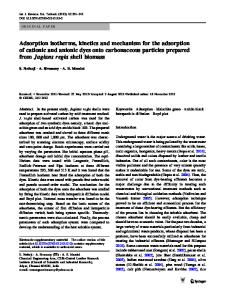Adsorption Kinetics of Polyvinyl Acetate Adsorbed at the Solid-Liquid Interface
- PDF / 299,441 Bytes
- 6 Pages / 420.48 x 639 pts Page_size
- 86 Downloads / 298 Views
ADSORPTION KINETICS OF POLYVINYL ACETATE ADSORBED AT THE SOLID-LIQUID INTERFACE
H. TERASHIMA, K. KANEHASHI AND N. IMAI Institute of Applied Physics, University of Tsukuba, Tsukuba 305,
JAPAN
ABSTRACT The kinetics of adsorption of polyvinyl acetate at the solid-liquid interface has been studied to verify the correctness of a description in a paper (Peterson and Kwel, J.Phys.Chem. 65, 1330(1961)] : "the initial rate of adsorption of polyvinyl acetate was found to be rapid". This is inconsistent with the widely accepted knowledge that polymer adsorption is a slow process. Polyvinyl acetate (Mw = 124,800) was adsorbed from benzene (0.001 to 0.05 mg ml-1) onto mica at 295.5 K. The adsorbed amount per unit area i.e. adsorbance has been determined as a function of incubation time using an ultramicrobalance [Mettler UM3]. The results obtained show that the adsorbance rises rapidly at the beginning of adsorption and then reaches an apparent plateau, where the adsorbance still increases at negligibly slow rate in comparison with the initial rate. The Peterson and Kwei's results have been confirmed to be correct. We regarded the plateau as an adsorption equilibrium and constructed adsorption isotherms, in which the Peterson and Kwei's results were incorporated. These isotherms are found to be less dependent on concentration in the dilute region concerned. This dependency is in agreement with the prediction of the Scheutjens and Fleer theory based on the loop-train-tail model. INTRODUCTION Polymer adsorption at the solid-liquid interface has been recognized to be a slow process in comparison with adsorption of low molecular weight substances. Therefore, in most of experimental works aimed at determining adsorption isotherms of polymer molecules, the adsorbed amount has been measured after long period of incubation time. The adsorption isotherms determined in this way are usually rounded against the axis of abscissa representing solution concentrations ; the adsorbed amount increases at lower concentrations and reaches a pseudo plateau at higher concentrations. On the other hand, the Scheutjens and Fleer theory[l] formulated on the basis of the loop-train-tail model predicts the "flat" isotherms without any initial steep increases in adsorbed amount with solution concentration ; the pseudo plateau region extends down to extremely low concentrations. Such a difference in shape between the experimental and theoretical isotherms has been pointed out by Tadros[2]. We have recently reported[3] that the said disagreement between the experimental results and the theoretical prediction is considered to be caused by an inappropriate way of determining the adsorbed amount at equilibrium. This is because it has been revealed that polymer adsorption is not a slow process but a rapid one. According to our experiments on the adsorption kinetics of polystyrene from cyclohexane onto mica, the adsorbed amount has been found to rise rapidly at the beginning of adsorption and reach an apparent plateau value within a few minutes even at very lo
Data Loading...










